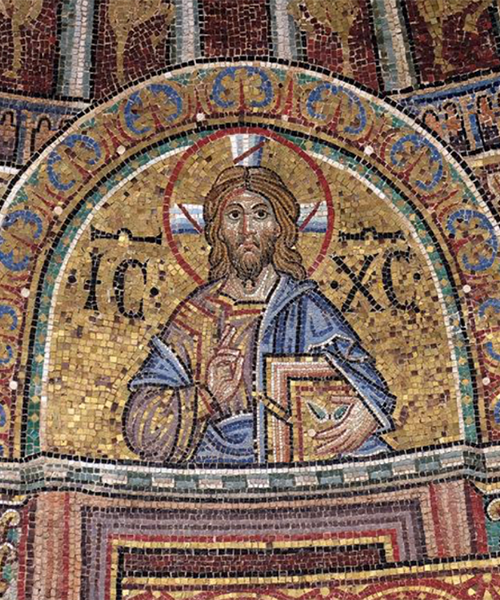Mosaic, a medium comprising natural stone and/or glass and pasta vitrea (glass paste) tesserae or cubes set into the mortar, is among the most durable and prestigious art forms of medieval Italy. According to Pliny the art of setting mosaic pavements reached Italy “in the time of Sulla” (c. 85 BCE), but the use of mosaic to adorn walls, arches, and vaults—the primary focus of this article—was still a “recent invention” at the time Pliny was writing (77–79 CE). Used most commonly for garden niches (e.g., Pompeii), mural and vault mosaics became much more common in the early 4th century, serving as the medium of choice for narrative and iconic imagery on walls and vaulting of Christian churches, often highlighting the sacred space of the sanctuary apse. The earliest Christian mosaics are found on the vaults of funerary spaces in Rome and in the pavements of the double cathedral complex at Aquileia, northeast of Venice, made in the first decades of the 4th century. Initially associated with imperial patronage, mosaic came to be the preferred medium for papal and episcopal commissions in Rome and Ravenna, and later for royal, ducal, and civic commissions in Florence, Venice, and Norman Sicily. Mosaic continued to enjoy great prestige as a medium in Florence, Rome, and Venice until the 15th century, but the development of illusionistic effects in fresco led to the gradual eclipse of the medium. This article begins with a series of thematic sections, including foundational studies, technical studies, and surveys, and a selection of distinct interpretive approaches, and then turns to the principal sites of mosaic decoration in Italy arranged by city and region. Mosaic pavements are treated in a separate section at the end.
Another historiographic focus, exemplified in Demus 1970 and Kitzinger 1960 (cited under Monreale Cathedral), is the role of Byzantium, first as a direct source of materials and craftsmen immediately before and after the Byzantine conquest of the peninsula in the 540s, again in the 11th century via Monte Cassino—where Byzantine craftsmen were imported to rebuild the abbey under Desiderius—and, finally, in a series of “waves” of “influence” during the Comnenian dynasty of the 12th century, manifested in the mosaics of Norman Sicily and of Venice and the upper Adriatic region. Demus 1993 also suggests that the hierarchical disposition of images in space, developed in Middle Byzantine mosaic decoration, was adapted to local architectural contexts and ideological needs in Italian churches in Venice and Norman Sicily. A more recent study, Tronzo 1997 (cited under Cappella Palatina, Palermo) has questioned the idea of stylistic “influence,” preferring to see intentional processes of appropriation and modification. Considerable attention has also been given to the history of technique and restoration of mosaics in order to understand changes over time and provide more accurate dating criteria, and this is reflected in introductory overviews of mosaic art in Bertelli 1989 and Poeschke 2010. Later 20th-century iconographic studies have shifted emphasis from tracing sources to discerning programmatic narratives in relation to biblical exegesis and theology, institutional politics and ritual functions, and gender. Mathews 1993 offers a significant critique of the focus on the imperial origins of Christian iconography, shifting attention to the Christian adaptation of Roman religious iconography. The author applies this theory to the apse mosaic of Santa Pudenziana in Rome and to the processions of crown-bearing apostles and saints in the mosaics of the Ravenna baptisteries and Sant’Apollinare Nuovo. A recent collection of essays, Jefferson and Jensen 2015, investigates the implications of Mathews’s critique, articulating with more nuance the various ways early Christian art adopted, adapted, and subverted Roman imperial, religious, and secular imagery. Since the 1990s, scholarship has shifted emphasis again to focus on phenomenological aspects, materiality, and the senses.

